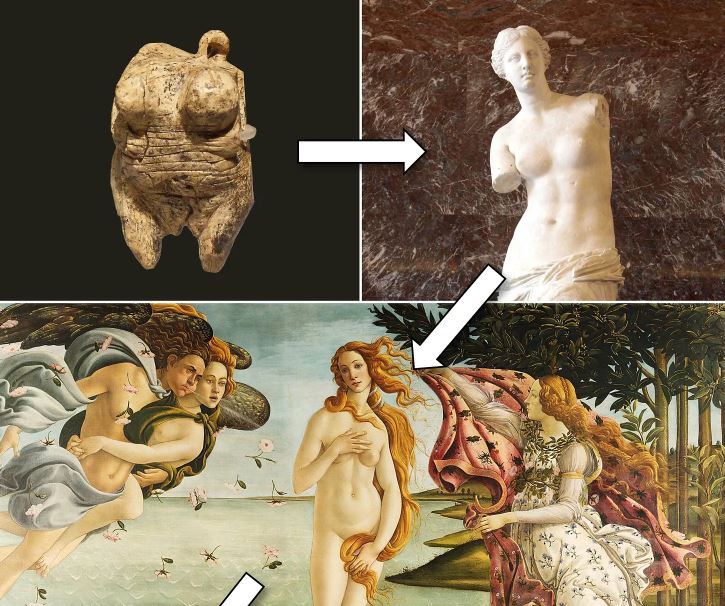“A History of the World in 5 Nudes”

What 40,000 years of art reveals about us…

What do our clothes really cover? When we remove them, what is revealed?
Nudes are among the oldest and most ubiquitous forms of art that human culture has created, but they vary widely from era to era.
These five pieces tell the story of nude art — and, more importantly, the story of the cultures that created them…
The Venus of Hohle Fels

The story of nude art begins with the oldest undisputed depiction of a human form: a 40,000-year-old statue discovered in the Hohle Fels cave of Germany.
Known as the Venus of Hohle Fels, the carving is a visceral, yet compelling depiction of a female body. Its exaggerated feminine characteristics indicate that it’s a celebration of fertility, likely worn as an amulet or used in religious ceremonies.
The unabashed nudity of the Hohle Fels Venus connects human fertility to the fecundity of the natural world, which, in early cultures, was inseparable from the activity of gods and goddesses. This early sculpture reveals a world in which the power of divine beings was visible in the cycle of seasons, the hunting of prey, and the human body alike.
The Venus de Milo

By the 2nd century BC, artists had learned to smooth out the rough edges of their carvings. The raw harshness of the Hohle Fels Venus gave way to the pristine perfection of the Venus de Milo.
The statue is thought to depict the goddess Aphrodite holding the golden apple of discord, which was awarded to her by Paris for being the most beautiful goddess — this event is known as the “Judgement of Paris”, and is what kicked off the events of the Trojan War. Though the statue’s arms are now missing, the figure’s graceful pose, cascading drapery, and classical features have made it an icon of beauty through the ages.
Instead of depicting its deities as animals or natural elements, Greek tradition anthropomorphized its gods, presenting them in human form. Statues like the Venus de Milo confirm the connection between the human body and the divine, an ever-present consideration in Greek society.
Botticelli’s Birth of Venus

The rise of Christendom brought an emphasis on physical modesty to the Western world. Christian tradition eschewed nudity in art for almost 1500 years, making Botticelli’s Birth of Venus virtually the first nude painting in Christendom.
As the Renaissance began to blossom, Botticelli — along with the rest of Europe — turned to the pagan roots from which Christian culture sprung, hoping to reclaim the glory of the Greco-Roman world and integrate it into the Christian one. This included the pagan tradition of representing the unclothed human body.
Botticelli, however, nuanced the pre-Christian connection between nudity and divinity. Instead of emphasizing the body’s connection to the natural world or sexual desire, he hoped to portray the beauty of the human form in a way that would allow the viewer to contemplate the beauty of God. Following in his footsteps, cherubs, nymphs, and classical figures would soon dance across Renaissance canvases everywhere, seeking to reclaim nude art from the taboo of paganism.
Manet’s Le Déjeuner sur l’herbe

The Renaissance successfully reintegrated nude art into the Christianized West, but these nudes were generally limited to mythological figures, such as goddesses and heroes, who transcended everyday life.
The art world reeled in shock, then, when Edouard Manet debuted his 1863 piece entitled Le Déjeuner sur l’herbe (“Luncheon on the Grass”). Depicting actual women in an everyday setting, the painting took nudity out of the realm of mythology and placed it in the realm of the real. Though the garden-like context and graceful poses of the women harken back to paintings of Greek nymphs, the contrast between the mythological elements and the matter-of-fact nudity only sharpened the shock.
Manet’s painting was one of the first nude works to disconnect human nudity from transcendence, and the artistic establishment of the time resolutely rejected it. The nude women no longer stood in as images of primordial goddesses or beautiful nymphs — instead, they simply represented themselves.
Marilyn Monroe in Playboy

Only 90 years after Manet published his painting, Playboy published its first issue. The cover promised a full-color nude photo of Marilyn Monroe, and the centerfold delivered.
The photograph is iconic of the 20th century’s explosion of explicit images. From films to advertisements to books, sexual imagery began to saturate mass culture.
While humanity has been creating nude images for tens of thousands of years, this type of art represents something distinct from the mainstream art that preceded it. Classical nudes considered the mystery of the human body and saw it as a doorway to the divine. Modern photographs, on the other hand, showed bodies for the purpose of sexual enjoyment — or in other words, pornography.
This chapter of nudity disconnects the human body from higher meaning. A nude body on the pages of Playboy exists to appeal to the viewer’s physical desires and make a profit, rather than to inspire or ennoble.
(Un)clothed in Mystery
But the story of nude art is nothing less than the story of how we see ourselves. Some nude works demonstrate that, beneath the everyday trappings of life, human beings are images of the divine…



